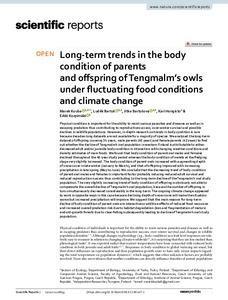Long-term trends in the body condition of parents and offspring of Tengmalm's owls under fluctuating food conditions and climate change
Kouba Marek; Bartoš Luděk; Bartošová Jitka; Hongisto Kari; Korpimäki Erkki
Long-term trends in the body condition of parents and offspring of Tengmalm's owls under fluctuating food conditions and climate change
Kouba Marek
Bartoš Luděk
Bartošová Jitka
Hongisto Kari
Korpimäki Erkki
NATURE PORTFOLIO
Julkaisun pysyvä osoite on:
https://urn.fi/URN:NBN:fi-fe2021110253342
https://urn.fi/URN:NBN:fi-fe2021110253342
Tiivistelmä
Physical condition is important for the ability to resist various parasites and diseases as well as in escaping predators thus contributing to reproductive success, over-winter survival and possible declines in wildlife populations. However, in-depth research on trends in body condition is rare because decades-long datasets are not available for a majority of species. We analysed the long-term dataset of offspring covering 34 years, male parents (40 years) and female parents (42 years) to find out whether the decline of Tengmalm's owl population in western Finland is attributable to either decreased adult and/or juvenile body condition in interaction with changing weather conditions and density estimates of main foods. We found that body condition of parent owl males and females declined throughout the 40-year study period whereas the body condition of owlets at the fledging stage very slightly increased. The body condition of parent owls increased with augmenting depth of snow cover in late winter (January to March), and that of offspring improved with increasing precipitation in late spring (May to June). We conclude that the decreasing trend of body condition of parent owl males and females is important factor probably inducing reduced adult survival and reduced reproduction success thus contributing to the long-term decline of the Tengmalm's owl study population. The very slightly increasing trend of body condition of offspring is obviously not able to compensate the overall decline of Tengmalm's owl population, because the number of offspring in turn simultaneously decreased considerably in the long-term. The ongoing climate change appeared to work in opposite ways in this case because declining depth of snow cover will make the situation worse but increased precipitation will improve. We suggest that the main reasons for long-term decline of body condition of parent owls are interactive or additive effects of reduced food resources and increased overall predation risk due to habitat degradation (loss and fragmentation of mature and old-growth forests due to clear-felling) subsequently leading to decline of Tengmalm's owl study population.
Kokoelmat
- Rinnakkaistallenteet [27094]
